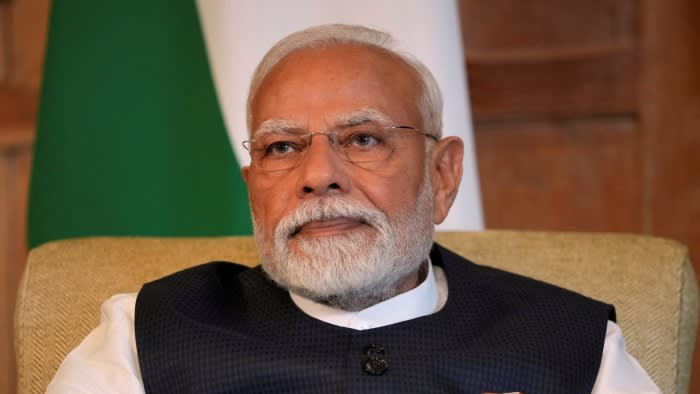
This article is an on-site version of our Moral Money newsletter. Premium subscribers can sign up here to get the newsletter delivered twice a week. Standard subscribers can upgrade to Premium here, or explore all FT newsletters.
Visit our Moral Money hub for all the latest ESG news, opinion and analysis from around the FT
Greetings from the Financial Times’ Mumbai bureau where I’m filling in for Simon while he’s away.
India’s energy transition was the focus of a two-day FT summit in Delhi I attended a couple of weeks ago. Despite India being the world’s third-biggest carbon emitter, Prime Minister Narendra Modi’s administration is adamant that it is leading the charge on clean power, while burning an increasing amount of the country’s abundant and cheap coal to meet ever-rising energy demand.
Along with discussions on electric vehicles, the mechanics of renewable tariffs and distribution networks, one topic that surfaced repeatedly was India’s anticipated plans to open up nuclear power to private investors in an effort to expand low-carbon energy access.
Modi’s government prepares to liberalise nuclear power industry
“As far as nuclear internationally is concerned, we are at a sweet spot, almost like the 1970s after the oil shock,” Shah-Nawaz Ahmad, a senior adviser at the World Nuclear Association, told the audience in Delhi last month. “India is already, in a sense, ahead of the curve . . . the recent announcements that have come obviously are intended as a game-changer.”
Ahmad was referring to a potentially historic shift. While India built Asia’s first research nuclear reactor in 1954, Modi’s government is only now preparing to loosen the state’s decades-old monopoly control of the industry. In March, Jitendra Singh, a minister heading up India’s atomic energy department, said the decision “breaks past taboos” for India, whose “nuclear programme has traditionally operated behind a veil of secrecy”.
Those moves could open the door to major domestic groups such as Tata Power, as well as global nuclear specialists including France’s EDF, Russia’s Rosatom and the US’s Westinghouse, which are eyeing up opportunities in India.
Currently, India operates 25 nuclear reactors producing a measly 8.8 gigawatts of energy, with the government aiming to hit 22GW by 2032 under this privatisation push. Ultimately Modi wants that figure to reach 100GW by 2047, when India celebrates 100 years since its freedom from colonial rule.
During India’s budget presentation in February, finance minister Nirmala Sitharaman also outlined plans for a Rs200bn ($2.2bn) national Nuclear Energy Mission to develop by 2033 at least five locally developed small modular reactors. The modern technology typically generates less than 300 megawatt of capacity with reduced construction times and costs compared with larger plants.
India is hardly alone in seeking to reinvigorate nuclear power, which is back in global vogue as governments around the world fret about energy security and decarbonisation.
Belgium and Germany have reversed earlier decisions to phase out reactors and the World Bank in June lifted its decades-long ban on financing nuclear energy to help encourage the development of low-emissions technology. The US, the world’s leader by reactor count, has pledged to quadruple capacity by 2050 under Donald Trump’s pro-nuclear administration.
Nuclear advocates tout the energy for having the lowest carbon footprint, stability compared with intermittent solar and wind, and a long operating life.
India’s government is looking at changing laws that have stalled and stymied past investment as nuclear developers are held liable for potential accidents, which no other country imposes.
Fear of safety and waste disposal in India, like elsewhere in the world after the Fukushima, Chornobyl and Three Mile Island plant disasters, loom large in the public imagination. It is something New Delhi and the industry will have to overcome.
The densely populated country has a history of resistance to large infrastructure projects and acquiring land for new reactors could prove a major stumbling block.
Analysts at Bernstein recently chronicled the Kudankulam nuclear plant in the southern state of Tamil Nadu.
The first agreement with the Soviet Union was signed in 1988. Land was acquired the same year. Yet local protests, the dissolution of the USSR, and repeated construction halts meant that the first reactor did not start operating until 2014. At one point, between 2011 and 2012, local opposition grew so strong that workers were barred from the site for six months.
“After the liability law, safety perception would be the second important challenge the country will face,” said Arunendra Tiwari, a fellow at The Energy and Resources Institute in New Delhi, at the FT summit. “People don’t like nuclear power plants in their back yard.”
Then there is the money. Building nuclear power plants requires huge upfront investment, far higher than for wind or solar. Uranium prices have also soared, putting longer-term costs beyond the large upfront reactor construction costs into focus. The smaller reactors promoted as a way to ease some of the expense also remain unproven at a commercial scale. Whether India has a qualified workforce is also in question.
“A crucial yet often overlooked obstacle to these ambitions is the dwindling academic interest and institutional capacity for nuclear engineering within the country,” Kavya Wadhwa, a nuclear energy advocate and policy analyst at India’s Observer Research Foundation think-tank, wrote in a recent report.
At least six out of eight Indian universities that had set up nuclear engineering MTech programmes between 2010 and 2020 have now shut down those specialised courses, according to Wadhwa. And even if those bottlenecks are overcome, India’s nuclear ambitions will still remain but a fraction of Modi’s overall target to hit 1,800GW of renewable energy capacity by 2047.
Smart reads
Chicago reparations The city’s liberal Evanston suburb set up a fund to compensate Black citizens for residential racism, and has since expanded it. Will others follow?
Meat substitutes Can plant-based alternatives scale quickly enough, stay affordable, and persuade people to change what ends up on their plates?
Nigerian solar Fed up with the country’s regular blackouts, wealthier households in Africa’s largest oil producer have been the first to rush to install cheap, imported solar panels.


